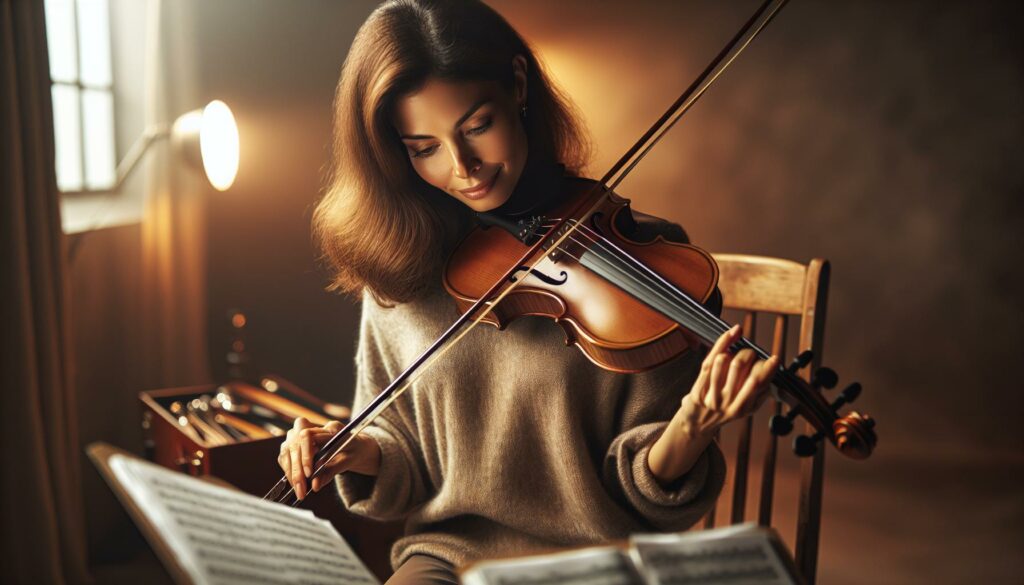Learning to play the violin as an adult might seem daunting, but it’s an incredibly rewarding journey. I’ve discovered that picking up this beautiful instrument later in life opens up a world of creativity and personal growth. Whether you’ve always dreamed of playing or just want to challenge yourself, it’s never too late to start.
Key Takeaways
- Rewarding Journey: Learning the violin as an adult opens doors to creativity, personal growth, and emotional expression, proving that it’s never too late to start playing.
- Cognitive and Emotional Benefits: Adult learners experience enhanced cognitive functions, improved memory, and emotional well-being through music, fostering discipline and reducing stress.
- Challenges and Solutions: Common challenges like time management and physical limitations can be overcome with consistent practice schedules and proper ergonomics.
- Selecting the Right Equipment: Choosing the right violin and accessories is crucial for comfort and quality of sound. Options include acoustic, electric, and student violins.
- Effective Learning Strategies: Utilizing the right instructor, self-teaching resources, and setting realistic goals can significantly enhance the learning experience for adult violinists.
- Balanced Goal Setting: Establishing short-term and long-term goals aids in maintaining motivation and progress, ensuring a fulfilling musical journey.
Learning Violin as an Adult
Learning the violin as an adult offers numerous advantages that enhance both the mind and mood. Engaging in this musical pursuit fosters cognitive and emotional development.
Cognitive Benefits
Learning an instrument boosts cognitive function, improving memory and problem-solving skills. Playing the violin requires multitasking, as it combines reading music, coordinating finger movements, and maintaining rhythm. This type of mental exercise enhances brain connectivity. Studies indicate that adults who learn music experience better executive function, which affects planning, reasoning, and decision-making. Additionally, practicing the violin sharpens focus and discipline, reinforcing the ability to concentrate on tasks of varying complexity.
Emotional Benefits
Learning the violin as an adult nurtures emotional health and encourages self-expression. Making music stimulates the release of dopamine, a chemical linked to feelings of happiness and motivation. This process can reduce stress and anxiety levels, providing a productive outlet for emotions. Moreover, the sense of accomplishment from mastering a piece cultivates confidence, boosting self-esteem. The social aspect of learning music, such as participating in group classes or ensembles, fosters connections with others, creating a supportive community that can enhance interpersonal skills and emotional well-being.
Common Challenges Faced by Adult Learners
Adult learners often encounter specific challenges while learning the violin. Recognizing these hurdles can aid in finding effective solutions for a smoother learning experience.
Time Management
Balancing responsibilities poses a significant challenge for many adult learners. Work commitments, family obligations, and social activities can lead to limited practice time. Prioritizing a consistent schedule establishes a routine, enhancing progress. Setting specific practice goals, such as 30 minutes per day or three sessions per week, helps in managing time effectively. Utilizing tools like calendars or reminder apps can reinforce commitment to practice sessions.
Physical Limitations
Physical limitations might affect performance and progress while learning the violin. Factors such as stiffness, reduced flexibility, or previous injuries can impede playing technique. Incorporating warm-up exercises before practice can alleviate tension and enhance mobility. Taking regular breaks during practice sessions prevents fatigue and minimizes discomfort. Additionally, using ergonomically designed violins or adjusting posture improves playing comfort and reduces strain on the body.
Choosing the Right Violin and Equipment
Selecting the right violin and equipment is crucial for a successful learning experience. The right choices can enhance comfort and performance, making it easier to develop skills.
Types of Violins
I recommend considering several violin types before making a purchase.
- Acoustic Violins: These traditional instruments produce sound naturally. They come in various sizes, which is important for adult learners to choose the correct fit.
- Electric Violins: With built-in pickups, electric violins connect to amplifiers. They’re ideal for practicing silently with headphones, which suits urban settings.
- Student Violins: Designed for beginners, student violins offer a balance of affordability and quality. Brands like Yamaha and Cremona are popular choices.
- Professional Violins: More advanced instruments provide superior sound quality and craftsmanship. Look for violins from reputable makers, but expect higher prices.
Essential Accessories
Choosing the right accessories enhances the learning process.
- Bow: A well-balanced bow is essential for producing quality sound. It should be lightweight yet durable.
- Chin Rest: An adjustable chin rest promotes comfort and proper posture. Proper fitting leads to better positioning while playing.
- Shoulder Rest: This accessory can reduce strain on the shoulder and neck. Adjustable options provide personalized comfort.
- Rosin: Applying rosin to the bow hair increases grip and sound quality. Regular use enhances tone production.
- Case: A protective case is necessary for transport and storage. Consider options with padding and compartments for accessories.
Selecting the appropriate violin and equipment sets the foundation for a rewarding musical journey.
Effective Learning Strategies
Effective learning strategies significantly enhance the experience of learning the violin as an adult. Implementing structured approaches leads to greater progress and enjoyment in this musical journey.
Finding the Right Instructor
Finding the right instructor plays a crucial role in learning the violin. Look for an instructor experienced with adult learners. Instructors should adapt their teaching methods to respect individual learning paces and styles. Consider factors such as teaching style, communication skills, and credentials. Scheduling regular lessons helps maintain accountability and establishes a routine. Seeking recommendations from fellow musicians or music schools can yield valuable options.
Self-Teaching Resources
Self-teaching resources provide a flexible alternative for adult learners. Online platforms offer video tutorials, sheet music, and interactive apps. Utilizing resources like YouTube channels and dedicated violin learning websites can supplement formal lessons. Investing in instructional books that emphasize technique and music theory strengthens foundational skills. Engaging with online communities or forums allows for sharing experiences and receiving feedback from peers. Prioritize resources that cater to specific goals, ensuring efficient progress.
Setting Realistic Goals and Expectations
Setting realistic goals fosters a positive learning environment when I learn the violin as an adult. It’s essential to distinguish between short-term and long-term goals for a balanced approach.
Short-Term Goals
Short-term goals focus on immediate progress and motivation. I can set achievable objectives, such as:
- Daily Practice Time: Commit to 20-30 minutes of focused practice each day.
- Specific Techniques: Work on particular bowing techniques or finger placements.
- Simple Pieces: Learn and perform short, simple pieces within a few weeks.
- Skill Assessments: Regularly assess my progress, such as mastering a scale or a specific measure.
These short-term markers help me maintain momentum and provide a sense of accomplishment, making learning engaging and satisfying.
Long-Term Goals
Long-term goals provide direction for my overall learning experience. I can establish these objectives to keep my motivation strong, such as:
- Mastering Intermediate Repertoire: Aim to play intermediate-level pieces within six months to a year.
- Participating in Recitals: Prepare for public performances after a year of consistent practice.
- Joining Community Ensembles: Plan to join local orchestras or groups within a year to gain collaborative experience.
- Achieving Technical Proficiency: Strive for technical mastery, such as playing with correct intonation and rhythm.
Long-term goals ensure I remain focused and committed to my violin journey, while celebrating milestones along the way enhances personal growth.



